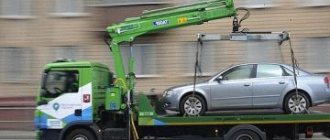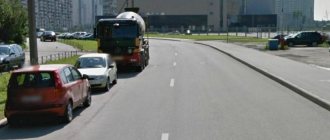Home / Vehicles
Back
Published: 04/08/2020
Reading time: 4 min
0
442
The situation of parking in the second row is very common and can create many problems for the driver, but it can be solved. Car owners may violate parking rules both due to a lack of parking spaces and due to simple disrespect for other drivers. There are also frequent cases of “parking wars” between neighbors, when they park in the second row to punish for illegally occupying a space. There are some tips for a car owner whose car is locked in a parking lot.
- Tip #1. View contact number under glass
- Tip #2. Bring to justice
- Tip #3. Call the traffic police
- conclusions
General information about illegal parking and fines
The basic rules of conduct for road users, including the rules for parking vehicles, are reflected in clause 12 of the traffic rules.
Thus, clause 12.1 of the traffic rules stipulates that a car can be parked on the right side of the roadway, as well as on part of the sidewalk path, if there is no shoulder and in the presence of permitting signs. When selecting a site for parking a car, you need to make sure that the selected site was not prohibited. Clause 12.4 of the Traffic Regulations provides for a prohibition on parking a vehicle in the following situations:
- On tram rails or close to the rails, as well as on railway rails.
- On overpasses, bridges and under these structures.
- In the tunnels.
- Closer than 5 meters to a pedestrian crossing or intersection.
- Closer than 15 meters to a general purpose vehicle stop.
- On the bike lane.
- Before sharp turns and in areas where the view is less than 100 meters.
- In areas where the car will cover road signs and traffic lights.
- In areas where a car will impede the movement of vehicles and people.
- In areas where the gap between a continuous marking strip (except for the strip outlining the edge of the roadway), a dividing strip or the opposite side of the roadway and a parked car is less than 3 meters.
According to clause 12.5 of the traffic rules, parking is prohibited:
- On main roads outside populated areas.
- Closer than 50 meters from the railway rails.
- If there is a “No Stopping” sign.
If a parked car is in the wrong area, the driver is awarded a fine, the amount of which depends on the type of traffic violation and ranges from 500 to 5,000 rubles.
Note. The violator is given 60 days from the date of receipt of the decision to pay off the monetary penalty. If the violator pays the fine within 20 days, he has the right to take advantage of a 50% discount.
Parking on the sidewalk
The most common punishment for motorists is when a vehicle is left on the sidewalk.
Even driving onto the curb of a sidewalk path with one wheel is perceived by a traffic police inspector as non-compliance with Part 3 of Art. 12.19 of the Code of Administrative Offenses, indicating that the car was left closer than 5 meters in front of the zebra crossing for people. Such disregard of traffic rules is subject to a penalty of 1,000 rubles. Part 6 art. 12.19 of the Code of Administrative Offenses states that the same illegal action carried out in large cities of the Russian Federation will be subject to a penalty of 3,000 rubles.
However, clause 12.2 of the traffic rules provides for the possibility of leaving the following vehicles on the edge of the sidewalk path:
- Bicycles, motorcycles, mopeds and passenger vehicles.
- In places with tabular signs 8.4.7, 8.6.2, 8.6.3, 8.6.6 – 8.6.9, which display the method of leaving a car on the sidewalk path, and with an attached sign 6.4 “Parking”.
Parking in disabled spaces
Illegal leaving of a vehicle in places marked “for disabled people” leads to a fine of up to 5,000 rubles. At the same time, it must be borne in mind that if a “disabled person” sign is attached to a car, this may not always mean that such a car can be left in a designated area. To do this, the motorist must have a document certifying his disability. In the absence of such a document, a sign on the car “for disabled people” will not help when leaving the car under such markings; the driver will have to pay a fine, based on Part 2 of Art. 12.19 of the Administrative Code, in the amount of 3,000 to 5,000 rubles (the amount varies in regions and cities).
Parking at bus and minibus stops
Public transport stop areas are always marked with appropriate signs. Therefore, other vehicles are prohibited from stopping vehicles in these areas closer than 15 meters from the attached sign. If this Rule is ignored, the driver is subject to punishment in accordance with Part 3.1 of Art. 12.19 of the Administrative Code, which provides for a fine of 3,000 rubles. If you are forced to leave your car, the fine is 1,000 rubles.
Types of fines for illegal parking in Moscow
- Fine for parking under prohibitory signs (different signs and fine amount)
- Fine for unpaid paid parking
- Fine (compensation) for towing a car in case of illegal parking
- Fine for parking in green areas (on the lawn)
- Fines for parking on the sidewalk
- Fine for parking in disabled spaces
- Fines for parking at bus and minibus stops
- Fine for second row parking
- Fine for parking in the yard
- Fine for parking on a tram lane
- Fine for parking on or near a zebra crossing
- Fine for parking near a railway crossing
Using general phrases, we note that the traffic police fine for parking is imposed in the case when a motorist places his vehicle in places that, for one reason or another, are not intended for this, or are not intended for certain types of placement (be it places for the disabled, places with regulated time frames for placement, places for placing certain types of vehicles or paid parking spaces).
Depending on the harm caused to society by the motorist, the monetary value of the punishment (fine) imposed on him also varies. In the case of large cities, the location and type of “wrong parking” also affects the type of organization that decides to impose a fine.
In the case of Moscow, this could be either the usual traffic police officers, or employees of the Moscow Administrative Road Inspectorate (MADI), representatives of the State Treasury Institution of the City of Moscow “Administrator of the Moscow Parking Space” AMPP (Mosparking), and in some cases, local police officers or even ecologists.
In rare situations, fines for illegal parking in Moscow bypass the standard route; they are not assigned a Unique Accrual Identifier (UIN) and are not reflected in the usual state databases. However, most parking fines follow the usual patterns. Thus, it is easy to check their availability online, and pay off the amounts of debts under the orders through special Internet services. An example of a service for paying parking fines, tested by many Moscow motorists, is here.
Is it possible to park second row according to traffic regulations?
First of all, let’s determine what the legislation says on this matter. Regarding parking in the second row, you need to be guided. It clearly states the following:
- All cars can only park in one row parallel to the edge of the road, unless markings 6.4 or signs 8.6.1 – 8.6.9 indicate otherwise.
- An exception is provided only for two-wheeled vehicles . Motorcycles, mopeds, scooters and other equipment of this type can stand in two rows. But only on the condition that they do not have trailers on the side. A motorcycle with a sidecar is no longer considered as a two-wheeled motor vehicle, but as a regular vehicle.
The requirements of clause 12.2 apply only to parking on the roadway. They do not apply to specially designated parking lots: multi-row parking is initially provided there.
On automotive websites you can sometimes find a statement that second-row parking is allowed in places where the road is mechanically widened (in “pockets”). This is mistake. Clause 12.2 of the Traffic Regulations does not say anything like that, and the “pocket” does not become a parking lot.
How to avoid getting fines for parking in Moscow (how to get away from a parking fine)
There are many methods for evading parking fees described on the Internet. All of them are illegal from one point of view or another. In response to the use of automatic complexes by the State Traffic Safety Inspectorate for recording violations of parking rules, some car owners began to hide their license plates using foreign objects, or even completely remove registration plates while the car was idle.
Such actions in a number of situations may affect parking fees, but have no future in the long term. Already, the State Duma is adopting packages of amendments obliging motorists to keep the car’s license plate readable even when parked.
The best way to avoid traffic police fines for parking is to study traffic rules and strictly follow them. The widespread legal and legal illiteracy of drivers leads to the fact that they themselves do not understand where and how they can leave the car. Knowing the traffic rules will relieve you of doubt and will always allow you to find the coveted parking space.
You can find out if you have any traffic or parking fines and pay them off instantly here.
02/17/2021ovrautozona
Related Posts
- How to pay traffic fines if there is no receipt05/26/2021
- Penalty for turning from the second row (not from your lane) (Article 12.14 and 12.16 of the Code of Administrative Offenses of the Russian Federation) smart answer & video05.26.2021
- How to pay a traffic police fine without commission 05/26/2021
What is second row parking?
The traffic rules are entirely devoted to the rules of stopping and parking vehicles. Drivers must adhere to a number of requirements:
- The car can be parked on the right side on the side of the road, and if there is none, then on the roadway, but no closer than 3 meters to the dividing strip of the solid line (clause 12.1 of the traffic rules).
- Stopping and parking on the left side is permitted for roads with one lane in populated areas, areas with one-way traffic, and in the absence of tram tracks. Transport over 3.5 tons can stop on the left side of one-way traffic only for loading and unloading (clause 12.1 of the traffic rules).
- Vehicles can only be parked in one row, parallel to the edge (Section 12.2 of the Traffic Regulations). The exception is two-wheeled vehicles without a trailer; such vehicles can be stopped in two rows.
A second-row stop is parking a vehicle parallel to an already parked vehicle, that is, closer to the middle of the roadway. The legislator (Administrative Code of the Russian Federation) prohibited this option, since parking in the second row can significantly impede travel on the road, blocking the traffic lane. Such a maneuver will also block the path of a car that was parked earlier.
What is the fine for second row parking?
Any violation of traffic rules entails a sanction established by law (Administrative Code of the Russian Federation). Illegal abandonment of a vehicle is no exception. The Traffic Regulations establish the ban itself, but the Traffic Regulations, as essentially a by-law, do not determine the punishment for parking a car in the second row.
The Code of Administrative Offenses of the Russian Federation is entirely devoted to violations of stopping and parking rules. Clause 3.2 contains penalties for leaving a vehicle further than the first row from the edge of the road. The violator will have to pay a fine of one and a half thousand rubles.
For Moscow and St. Petersburg, the legislator has determined other sanctions. Thus, paragraph 6 establishes the fine for parking in the second row in the amount of three thousand rubles.
In a situation where a car interferes with the passage of other vehicles, that is, interferes with traffic, paragraph 4 of the same article 12.19 applies. The fine for it will amount to two thousand rubles, and for Moscow and St. Petersburg, according to the same paragraph 6, the amount increases to three thousand.
Fine for illegal parking in Moscow 2020
For someone with a specific problem, this may be an unexpected obstacle. But there is no one generally accepted traffic police fine for parking, both in Moscow and in other Russian cities. The concept of a parking fine by the traffic police is extremely vague, it should at least be divided into three subtypes: fines issued by traffic police officers for violating the rules of parking/standing/stopping a vehicle on public roads, fines issued by parking space operators or the Moscow Administrative Road Inspectorate (MADI) for paid parking and border violations. The third type of parking fines is related to environmental standards and the placement of vehicles in the courtyards of residential buildings. In this situation, fines for illegal parking on the lawn or playground can be issued by both the local police officer and the environmentalist.
Soviet urban planning did not take into account the mass motorization of the population. The creators of the historical centers of the ancient cities of central Russia did not foresee the appearance of cars either.
The good news is that you can check and pay all these types of fines (including fines for unpaid parking ) instantly using our service.
Is there a discount on the fine?
A number of administrative fines for violating traffic rules can be paid with a fifty percent discount (Administrative Code of the Russian Federation). To do this, it is necessary to fully repay the debt within a period not exceeding 20 days from the date of the sanction.
The period is calculated from the moment of issuance, and not from the date the person receives the decision on a fine for parking in the second row (clause 1.3 of Article 32.2 of the Code of Administrative Offenses of the Russian Federation).
The Code of Administrative Offenses, which regulates leaving a car in the second row and other parking violations, is no exception. The fine can be paid at a discount if you meet the deadline.
How to challenge a fine
You can challenge a fine for illegal parking:
- First, you need to collect all the necessary documents (personal passport, car documents, etc.) and write a complaint. In your complaint, you must indicate the reasons why you do not agree with the imposition of a fine. The methods of challenging may vary and depend on the specific offense. For example, in the case of parking in a parking lot for the disabled, you can provide data from the dashcam, which shows that you were transporting a disabled person in your car.
- After this, you must submit this application to the local traffic police department. The application deadline is 10 days. You can submit your application later if you have a valid reason (for example, you did not have time to submit your application because you were undergoing treatment). After this, your application must be reviewed within 10 days and a decision must be made.
- If the traffic police reject your complaint (and this happens quite often), you can go to court. The court will consider your case from scratch. The period for consideration of your complaint in court is 2 months.
When there is no responsibility
In part 3.2 of Art. 12.19 of the Code of Administrative Offenses there is one important caveat. The idea is that parking in the second row is allowed in exceptional situations. These, for example, include the breakdown of important components and assemblies of the machine.
So, if the driver sees that he has problems with the brakes, he will simply be obliged to stop. The same goes for headlights and wipers (in bad weather). In addition, the reason for parking may be a sharp deterioration in the health of the driver or his passengers.
At the same time, there are a number of situations when the fact of stopping in the second row is not obvious. In this case, the driver can operate on the testimony of witnesses, photographs or video recordings.
A car lawyer can help the car owner defend his rights. He will provide not only his advice, but will also defend the driver’s interests in court. Practice shows that the arguments of an experienced lawyer convince judges to cancel the fine.
If you have been issued a fine and it is not clear what to do next, you can get free advice from a lawyer online or by phone. After this, you can already plan further actions.
Parking rules in a residential area
The traffic rules have only 2 rules governing parking in a residential area. Firstly, parking with the engine running is prohibited (to prevent exhaust smoke from entering the apartments). Secondly, parking of category “C” freight vehicles is prohibited. This is all established by clause 17.3, however, in addition to this, the traffic rules have general parking rules that prohibit parking a car on the lawn and on the sidewalk unless there is an appropriate sign nearby that allows such parking.
But parking rules in a residential area are regulated not only by traffic regulations. The Russian Federation has fire safety and sanitary standards, which all citizens must also comply with.
Fire safety standards require that cars be parked so as not to block the entry into the yard for special service vehicles.
And SanPiN 2.2.1/2.1.1.1200-03 establishes the following restrictions on parking near the house:
- parking for 10 cars can be located at a distance of up to 10m from the windows/entrance to the house;
- at a distance of 11-50m from the windows/entrance to the house, parking for 15 cars can be located;
- at a distance of 51-100 m from the windows/entrance to the house, parking for 25 cars can be located;
- at a distance of 101-300 meters from the windows/entrance to the house, parking for 35 cars can be located;
- At a distance of more than 300m from the windows/entrance to the house, parking for 50 cars can be located.
Fine for unpaid parking in Moscow
Just a few years ago, in 2013, after analyzing the opinions of domestic and foreign experts, the Moscow authorities decided to organize a paid parking zone in the historical center of the city. The extremely unpopular measure caused massive discontent among motorists, but partially helped solve the problem of traffic jams and gas pollution.
In 2021, the paid parking zone expanded to the Third Transport Ring and included more than two hundred different streets. The cost of paid parking in the capital now ranges from 40 to 130 rubles per hour, depending on the duration of parking and the specific location of the parked car. The administrator of the city's paid parking system is the State Public Institution “Administrator of the Moscow Parking Space” (GKU “AMPP”), this organization is engaged in maintaining the infrastructure, receiving money and issuing fines for unpaid parking.
The fine for non-payment of parking in Moscow is 2,500 rubles .
What is considered illegal parking in the yard and the amount of the fine for violation?
It is important to understand that parking rules in the courtyard of an apartment building are also regulated by traffic rules. Key points that motorists should pay attention to include:
- Stopping or parking a vehicle in the yard with the engine running is permissible for no more than 5 minutes. This time is enough to disembark or board passengers, as well as perform cargo manipulations. Failure to comply with this rule may result in a complaint from neighbors to the appropriate authority. Prolonged warming up of a car in a residential area in the winter is punishable in a similar manner. A traffic police inspector has the right to issue a fine in the amount of 1,500 to 3,000 rubles, depending on the size of the locality.
- Drivers of heavy vehicles are prohibited from leaving their vehicles in the courtyards of residential buildings. There are specially equipped pockets and parking lots for such vehicles. The fine also ranges from 1500 to 3000 rubles. This rule applies to vehicles whose weight exceeds 3.5 tons.
- Violations also include parking a vehicle on the sidewalk (). Such a decision may entail the evacuation of the vehicle. The owner will not only have to pay a fine for an incorrectly parked vehicle, but also pay for the work of the tow truck. The cost of tow truck services is paid according to the current price list, and the fine is 2000 rubles. When making such a decision, it should be taken into account that it is allowed to evacuate cars placed on sidewalks, including the adjacent territory and courtyards of apartment buildings.
- Difficult passage for other vehicles, including special services vehicles (ambulance, utilities, Ministry of Emergency Situations, etc.) also falls under the category of offense (). The amount of penalties is determined by the traffic police inspector depending on the danger that arose and the consequences of leaving the car in the wrong place. It can vary from 2000 to 3000 rubles.
- Parking in the yard near the garbage containers deserves special attention. The optimal distance is considered to be at least 5 m, which allows utility services to carry out their immediate duties without interference. A fine for parking a car closer than 5m from the location of garbage containers entails a fine in the name of the owner. The amount of penalties ranges from 2000 to 5000 rubles, depending on the situation.
Attention
Parking on the lawn located in the local area is also a violation of current legislation. In the courtyards of apartment buildings that have problems with the availability of free parking spaces, such a problem inevitably arises. Owners can appeal this decision of the car owner.
Tip #3. Call the traffic police
A call to the traffic police will be required so that the car owner is not only fined, but also cleared the passage - for this purpose, a single emergency phone number 112 has been created. Inspectors usually go to such exits on a residual basis after an accident . Therefore, you may have to wait more than one hour. After arrival, the employees will draw up a report on the administrative violation and try to contact the owner themselves.
If this is unsuccessful, the inspector will call a tow truck - this will also take time.
If the car is towed, then the violator will not only have to pay a fine for incorrect parking, which interfered with the passage of other vehicles, but also pay for the services of a tow truck to move the car. So, in Moscow he will have to pay 3,000 rubles. for motorcycles and cars with power up to 80 hp. s., 5000 rub. - for passenger cars with a power of 80-250 hp. s., 7000 rub. - for passenger cars with an engine capacity of more than 250 hp. With. Another 1000 rub. You will have to pay for every day the car is in the impound lot.
In St. Petersburg, you will have to pay about 3 thousand rubles for car evacuation services. and about 70 rubles per hour for being in the impound lot.
You should not evacuate the car yourself, since if damage is caused, the car owner may later demand compensation. Moreover, this may be regarded as theft or hooliganism.
Rights and responsibilities of a driver when stopped by traffic police officers
Parking in the local area - residents' rights
Parking lots in courtyards are built in accordance with sanitary standards and traffic regulations.
The entire area around the apartment building is at the common disposal of the residents. All decisions regarding the arrangement of parking lots must be made based on the results of a general vote. If 2/3 of the owners are “For”, the decision is made.
The rights of residents are supported by two documents:
- Minutes of the meeting of premises owners with the decision on the arrangement of the parking lot and signatures.
- A certified certificate about the area and composition of the local area.
How to get a parking space in the yard
A personal parking space can be given, sold, or rented.
In an ordinary yard it is difficult to rent or register a parking space. The owners of apartments in the building manage the adjacent territory together, on the basis of common shared ownership. None of the residents has the right to individually dispose of the yard or some part of it.
Sometimes neighbors in the yard mark their parking lots: they install blockers or tighten chains. It is illegal to do this; it is considered self-seizure of territory. Traffic police officers have the right to issue a fine of 5,000 rubles.
From the beginning of 2021, motorists can legally obtain a parking space near their home. With this law, parking spaces have become full-fledged real estate: they can be registered in the cadastral register, donated, sold, leased, bequeathed, and even left as collateral.
You must pay a tax for a legally registered parking space.
To assign a parking space to one of the residents, a general vote must be held. If two-thirds of the owners vote “For”, you can proceed to registering the land. First you need to register the selected plot, mark its boundaries, indicate its purpose and receive a cadastral number. Only then does the motorist become the owner of his own parking space.
If there is an HOA in an apartment building, it is easier to get a personal parking space. You need to find out how many parking spaces are in the yard, which of them are free and choose one of them. After this, a vote must be held at a meeting of residents.
What about commercial vehicles?
But parking commercial vehicles in the yard is a completely different story. Commercial transport is cargo (all kinds of KAMAZs, gazelles, trucks, equipment) and passenger (minibuses, buses, taxis) transport used by legal entities or individual entrepreneurs. So, on January 1, 2021, amendments to the Requirements, approved, came into force. . In accordance with them, from January 1, 2021, it is no longer possible to park such commercial vehicles in the courtyards of residential buildings.
The creation of parking lots on public territory within the boundaries of an element of the planning structure built up with apartment buildings is not allowed (clause 4 of the Requirements, approved by Order of the Ministry of Transport No. 199).
Is it possible to park trucks in the courtyards of residential buildings? You can do it like any other commercial vehicle! Let's look at the features of the innovation and tell you why the ban is not as strict as it seems.
- Firstly, it concerns cars that have returned from a flight or are parked after a work shift for overnight parking. That is, cars cannot be parked in courtyards; they must be parked in specially equipped parking lots. But if you drove into the yard to unload, say, the furniture of one of the residents, there is nothing illegal in such parking.
- Secondly, the ban applies only to cities of federal significance - Moscow, St. Petersburg and Sevastopol. This rule does not apply to other cities.
- Thirdly, the Order, like the Administrative Code, does not provide for any sanctions for violators. It is absolutely unclear who will monitor compliance with the requirements and how government agencies will react.
Is it possible to park a taxi in the courtyard of a residential building? Of course, but not for overnight stays. And again, if the car is used by the resident of the house to work in a taxi (without registering as an individual entrepreneur) and at the same time as personal transport, the Order is powerless - he parks it as his own, and not a commercial car. Another question is in which parking lot he parks it. If this is guest parking, then such placement is illegal. Only permanent parking, and only at a distance from a residential building!
Truck parking in a residential area
Truck, as they say, is different from truck. As for parking specifically, vehicles of this type should be divided into two categories: up to and over 3.5 tons.
Parking of freight vehicles over 3.5 tons must comply with the following rules:
- directly prohibits parking in a residential area for such vehicles unless they (parking lots) are marked with special signs/markings.
- In accordance with Part 1, violation of parking rules will result in a fine of 500 rubles. The same violation, but occurring in Moscow or St. Petersburg - 2,500 rubles (Part 5 of the same article).
Thus, unless parking lots are specially equipped for this type of transport, parking trucks over 3.5 tons in yards is prohibited .
With trucks with a maximum permissible weight of less than 3.5 tons, the situation is the opposite. Their parking is not regulated by separate standards, which means that such cars can be parked according to the same rules as cars.
Unloading and loading operations and personal transport of company employees
Separately, it is necessary to consider cases of stopping and parking vehicles that do not belong to residents of nearby houses, but are related to public premises (offices, shops, etc.) located in such houses.
Here it is worth talking about two types of vehicles - personal transport of employees of such public organizations and cars parked for the purpose of unloading and loading operations. With the first type everything is simple:
Personal transport of employees of companies located in a residential building must be located outside the local area.
As for work on unloading and loading products or materials, they must be carried out in compliance with the following standards:
- This type of work cannot be carried out on the side of facades that have windows and entrances. Permitted in the following places:
- ends without windows and doors;
- from underground tunnels;
- from highways;
- through special closed landing stages.
- If a public premises (attached to a residential building) has an area of less than 150 m², it is allowed not to equip special loading rooms.
We examined the requirements and possibilities for equipping parking in courtyards in terms of the weight of the car, where the owners live and parking time. We will not return to freight transport anymore. Let's move on to the parking standards for ordinary cars weighing up to 3.5 tons.
The nuances of parking in the yard
Regulatory acts strictly regulate the rules for parking cars in yards. But there are several nuances that car owners need to consider. This will allow you to defend your rights in case of unlawful actions of other owners or government officials. These points include:
- The fine for parking on the sidewalk is 2000 rubles and threatens the evacuation of the vehicle. But traffic regulations allow parking on the sidewalk if the distance for pedestrians to pass is at least 2 m between the house and the parked car.
- The Code of Administrative Offenses also prohibits through traffic through the local area. But to avoid a fine for your decision, you must move at a speed of no more than 20 km/h. And also stop for a few seconds in a place permitted for this. In this case, the motorist does not fall under the classification of the “drive through” violation. But he only moves at the permitted speed in the local area, observing the rules of parking in the courtyards of apartment buildings.
Sources
- https://RuShtraf.com/shtraf-za-nepravilnuyu-parkovku/
- https://urist-consult.com/parkovka-vtorym-ryadom.html
- https://zakon-voditel.ru/shtrafy-gibdd/shtraf-za-parkovku-vtorym-ryadom
- https://avt-yurist.ru/shtraf/shtraf-parkovku-vtorom-ryadu.html
- https://auto-pravda.online/shtrafy/396-shtraf-za-parkovku-pered-podezdom.html
- https://uslugi-gkh.ru/pridomovaya-territoriya/pravila-parkovki-vo-dvore/
- https://J.Etagi.com/stati/pravila-parkovki-vo-dvorakh-zhilykh-domo/
- https://pravoved.ru/journal/pravila-parkovki-vo-dvorakh-zhilykh-domov/
- https://urist-consult.com/pravila-parkovki-vo-dvorah.html











